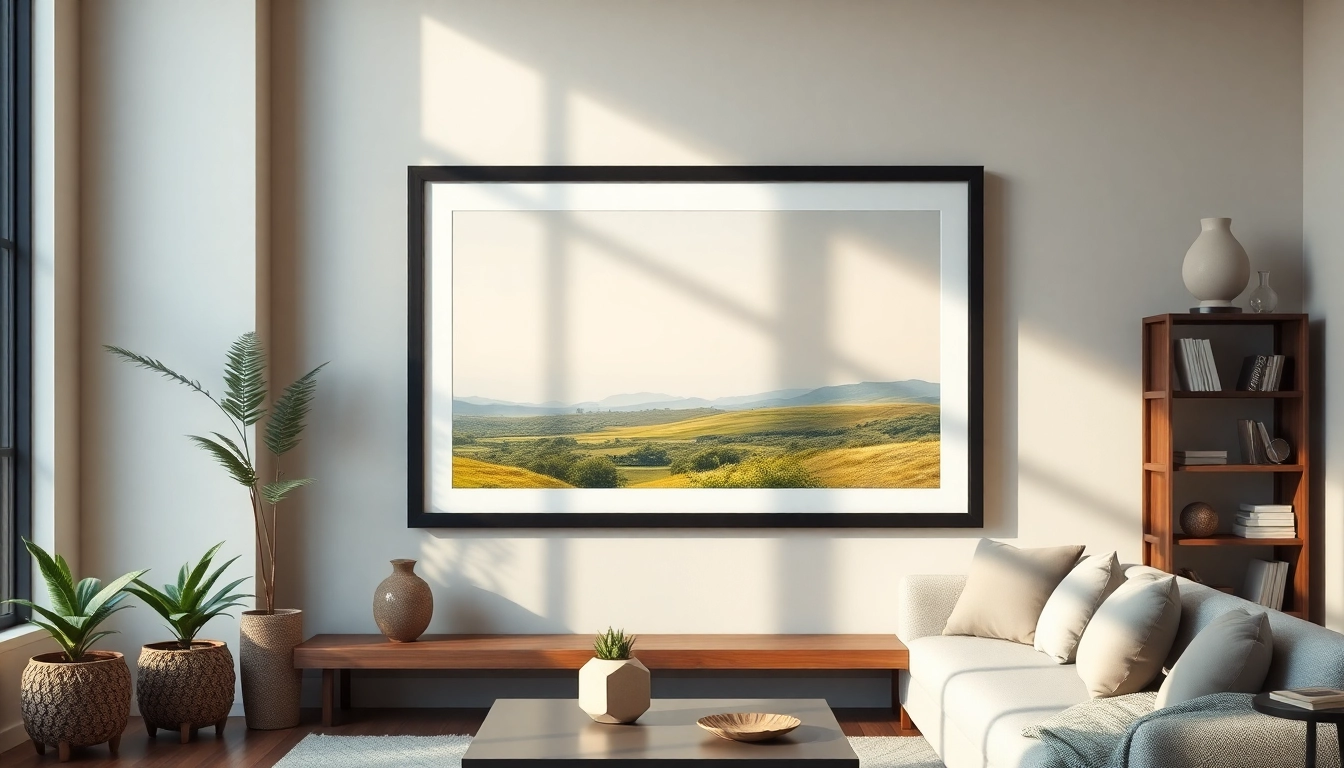Understanding the 20×30 Frame: Dimensions and Uses
What Is a 20×30 Frame?
A 20×30 frame is designed specifically to hold artwork, photography, or posters that measure 20 inches by 30 inches. This frame size has become increasingly popular due to its versatility and the eye-catching impact it creates in various display configurations. Beyond simply serving as a protective casing for your treasured images, a 20×30 frame adds an element of style and sophistication to your decor. Understanding the dimensions is paramount; the actual frame size will typically have an outer dimension of approximately 22×32 inches to accommodate the glass or acrylic cover and maybe a mat, making it imperative to consider these details when selecting your space for display.
Common Uses for 20×30 Frames
The applications of a 20×30 frame are numerous and varied. It is an excellent choice for artists and photographers looking to showcase their work eerily, as the size is often associated with showcasing significant events or beautiful scenic vistas. Common uses include:
- Exhibiting Photography: Photographers favor this size for landscape shots or detailed portraits where the larger surface area allows viewers to appreciate the finer details.
- Posters: Movie posters, concert advertisements, and art prints can be featured prominently in a 20×30 frame, making powerful decor statements.
- Certificates and Diplomas: Institutions often use this frame size for degrees or honors, providing an impressive visual for display in offices or homes.
Why Choose a 20×30 Frame Over Other Sizes?
Choosing a 20×30 frame over smaller or larger options can be advantageous for several reasons:
- Visual Impact: The sizable area allows for greater detail, ensuring that artworks or photographs attract attention and admiration.
- Flexibility in Display: Larger frames fit comfortably in many environments—from home, gallery, to office settings—enhancing any wall without overwhelming it.
- Customization Options: Many options are available with mats, colors, and materials to suit any personal style or decor theme.
Choosing the Right Materials for Your 20×30 Frame
Wood vs. Metal: Which Material Suits Your Style?
The choice between wood and metal for your 20×30 frame can significantly affect its overall appearance and durability. Wood frames often evoke a sense of warmth and tradition, with numerous finishes like oak, cherry, or walnut available. Additionally, they can add texture to your decor. On the other hand, metal frames, available in sleek finishes such as silver or black, impart a modern and minimalist aesthetic, making them suited for contemporary spaces.
Glass vs. Plexiglass: Making the Right Choice for Protection
When it comes to protecting your framed artwork, both glass and plexiglass have their merits. Glass provides superior clarity and scratch resistance but can be heavy and breakable. Plexiglass, while lighter and shatter-resistant, may scratch more easily but can also offer UV protection options, crucial for preserving color quality in photographs and artwork. Therefore, selecting the appropriate material often depends on the right balance between protection and aesthetic preference.
Exploring Eco-friendly Options for Your Frame
With increasing sustainability awareness, numerous eco-friendly materials for framing are gaining popularity. Bamboo frames are light, strong, and wholly renewable resources, while recycled composite wood frames provide attractive aesthetics. Additionally, recycled aluminum frames present a stylish yet eco-conscious choice. These options ensure that decorating your home with art is not just visually appealing but also contributes positively to the environment.
Design Tips for Displaying Your 20×30 Frame
Choosing the Right Location in Your Home
The placement of a 20×30 frame can greatly enhance its visual impact. Consider high-traffic areas such as living rooms, hallways, or above a fireplace to draw attention. Hanging the frame at eye level ensures optimal visibility. Additionally, don’t shy away from creative display locations—such as above a console table or adjacent to a gallery wall, where it can serve as a focal point against other framed pieces.
Complementing Colors and Styles for Visual Appeal
When decorating with a 20×30 frame, choosing complementary colors and styles can create a cohesive look. Consider the color palette of the room; a crisp white frame can brighten darker spaces, while a black frame may bring sophistication to modern decor. Additionally, the style of the frame—whether ornate or minimalist—should align with the overall theme of your space to maintain a harmonious aesthetic.
Arranging Multiple Frames for Impactful Gallery Walls
Creating a gallery wall can be an expressive way to showcase multiple 20×30 frames at once. To create an impactful arrangement, utilize a combination of frame styles, colors, and layouts. Start by laying out your frames on the floor to test various configurations before committing to nail holes. Balance larger 20×30 frames with smaller pieces to avoid a homogenized look; this creates visual interest and keeps the eye engaged.
Framing Techniques to Enhance Your 20×30 Artwork
Matting Options to Consider for Your Frame
Matting can enhance any artwork and provide a professional finish for your 20×30 frame. A mat board not only sets your artwork apart from the glass but also adds depth and visual interest. The choice of mat color, thickness, and texture matters—neutral shades tend to work best for colorful art, while vibrant mats can be used to complement or contrast the piece itself. Standard mat sizes for a 20×30 frame might range from 2 to 4 inches of exposure to maintain balanced proportions.
Decorative Styles: From Minimalist to Ornate
Your choice of decorative frame style will significantly influence the overall ambiance of your room. For minimalist decor, consider frames with clean lines and simple finishes. Alternatively, if your home features ornate details, classic frames with embellishments or distressed finishes can enhance aesthetics. Experimenting with unconventional styles—such as using unconventional colors or textures—can also yield stunning results.
How to Avoid Common Framing Mistakes
Framing can be deceptively challenging; a few common mistakes can undermine the overall effect. Avoiding overly busy backgrounds when displaying framed items will allow the artwork to speak for itself. Also, consider the scale of your frame in relation to surrounding items and spaces; a 20×30 frame will look lost in a crowded wall or too daunting in a small room. Finally, ensure that your artwork is properly secured to avoid bending or damage over time.
Maintaining Your 20×30 Frame for Longevity
Regular Cleaning and Care for Different Materials
To preserve the pristine appearance of your 20×30 frame, regular maintenance is essential. For glass frames, a mixture of vinegar and water is an effective cleaning solution. Always use a microfiber cloth to avoid scratching. Wood frames may require occasional dusting and treatment with a wood-friendly cleaner to preserve the finish, whereas metal frames should be wiped down with a damp cloth to avoid tarnishing.
How to Protect Your Frame from Damage
Protecting your 20×30 frame from physical and environmental damage requires a few strategic steps. Position your frame away from direct sunlight to minimize fading over time. Additionally, avoid placing it in high-humidity areas, such as bathrooms, which could warp materials, especially wood. Utilizing UV-filtering glass or acrylic can also help preserve artwork without compromising clarity.
When to Replace or Upgrade Your 20×30 Frame
Frames may need to be replaced or upgraded over time due to wear and changing decor styles. Consider replacing your frame if it exhibits visible damage, such as cracks or chips, which can detract from the overall appearance. Alternatively, if you decide to refresh your home decor, rather than merely switching out artwork, consider upgrading your frame to better complement the updated theme.



